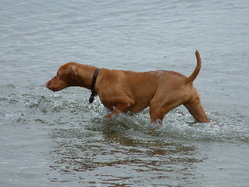
Hungarian Pointer
Magyar Vizsla
|
From Wikipedia the free encyclopedia, by MultiMedia |
| Hungarian Vizsla | ||
|---|---|---|

A Young Vizsla
|
||
| Alternative names | ||
| Vizsla Hungarian Pointer Magyar Vizsla |
||
| Country of origin | ||
| Hungary | ||
| Common nicknames | ||
| Classification and breed standards | ||
| FCI: | Group 7 Section 1 #57 | |
| AKC: | Sporting | |
| ANKC: | Group 3 (GunDogs) | |
| CKC: | Group 1 - Sporting Dogs | |
| KC (UK): | GunDog | |
| NZKC: | GunDog | |
| UKC: | Gun Dog Breeds | |
| Not recognized by any major kennel club | ||
| This breed of Dog is extinct | ||
| Notes | ||
The Hungarian Vizsla, pronounced VEEZH-la (zh as in vision), is a Dog breed originating in Hungary. Vizslas are known as excellent hunting Dogs, and also have a level personality making them suited for families.
The Vizsla, as described in the AKC standard, is a medium-sized short-coated hunting Dog of distinguished appearance and bearing. Robust but rather lightly built; the coat is an attractive solid golden rust.
The breed comes in either of two coat types: smooth or wire-haired. The FCI, CKC, and the KC(UK) consider the smooth-haired and wire-haired as separate breeds. Male Vizslas typically weigh between 55 and 65 lb (25 to 29 kg) and are 22 to 24 in. tall at the whithers, females 45 to 55 lb (20 to 25 kg) and are 21 to 23 in. tall.
Vizslas are lively, gentle mannered, loyal and highly affectionate. They quickly form close bonds with their owners. They are natural hunters with an excellent ability to take training. Not only are they great pointers, but they are excellent retrievers as well.
Like all sporting breeds, Vizslas require a good deal of exercise to remain healthy and happy. A bored Vizsla is a destructive Vizsla who is likely to engage in unwanted behavior, including chewing anything and everything in your home. Thirty minutes to an hour of exercise daily in a large off-leash area is optimal. Vizslas are excellent swimmers and often swim in pools if one is available.
There are two prevailing theories pertaining to the Vizsla's history. The first, and most prevalent theory traces the Vizsla back to very early times in Hungarian history. Ancestors of today's Vizsla were the hunting Dogs used by the Magyar tribes living in the Carpathian Basin in the Eighth Century. Primitive stone etchings seem to validate this theory.
The other theory holds that the Vizsla is a product of the nineteenth century, having been the product of other pointer breeds.
Dogs, made by MultiMedia | Free content and software
This guide is licensed under the GNU Free Documentation License. It uses material from the Wikipedia.